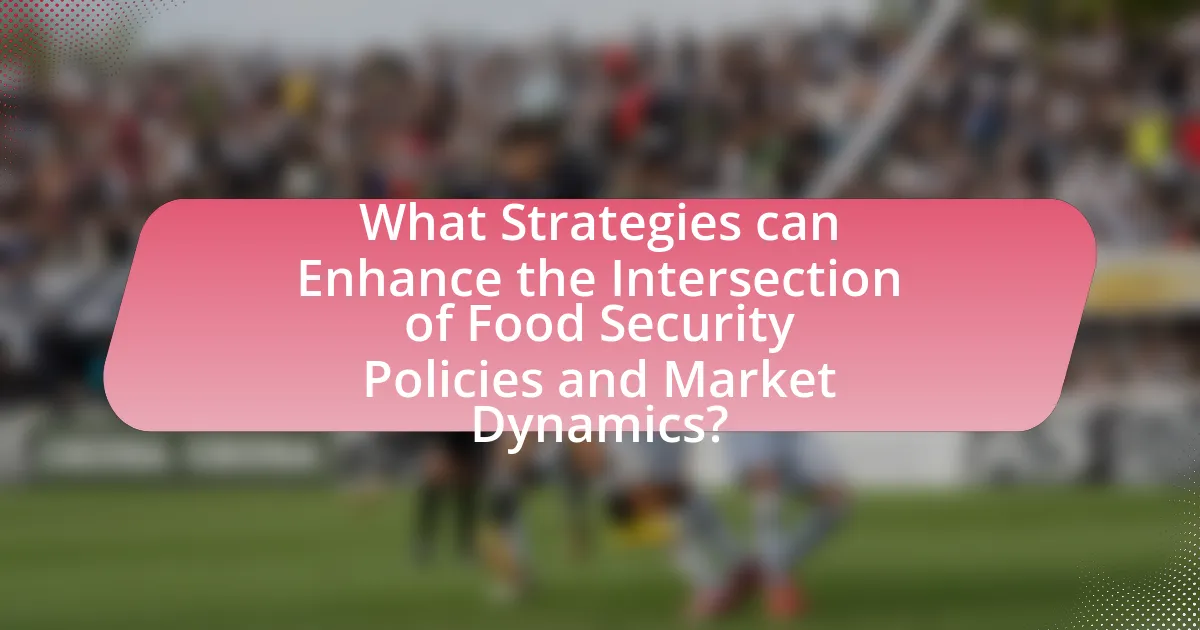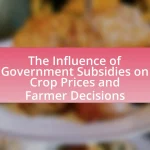The article examines the intersection of food security policies and market dynamics, defining food security policies as strategic frameworks aimed at ensuring access to sufficient, safe, and nutritious food. It highlights how these policies influence market conditions through mechanisms such as subsidies and price controls, while also addressing the challenges posed by market volatility and supply chain disruptions. Key components of effective food security policies include availability, access, utilization, and stability of food resources. The article further explores the implications for consumers and agricultural producers, the barriers to effective policy implementation, and future trends that emphasize sustainability and technological innovation in food systems.

What are Food Security Policies and Market Dynamics?
Food security policies are strategic frameworks implemented by governments and organizations to ensure that all individuals have access to sufficient, safe, and nutritious food to maintain a healthy life. These policies often address issues such as food availability, access, utilization, and stability, aiming to reduce hunger and malnutrition. Market dynamics refer to the forces that influence the supply and demand of food products, including pricing, consumer behavior, and agricultural production. The interaction between food security policies and market dynamics is critical; effective policies can stabilize markets and enhance food access, while market fluctuations can impact the effectiveness of these policies. For instance, during the 2007-2008 global food crisis, rising food prices highlighted the need for robust food security policies to mitigate the adverse effects on vulnerable populations.
How do Food Security Policies influence Market Dynamics?
Food security policies significantly influence market dynamics by shaping supply and demand conditions in agricultural markets. These policies, such as subsidies, price controls, and import/export regulations, directly affect the availability and pricing of food products. For instance, when a government implements subsidies for staple crops, it can lower production costs, leading to increased supply and potentially lower market prices. Conversely, import restrictions can reduce supply, driving prices up. Historical data from the World Bank indicates that countries with robust food security policies often experience more stable food prices and reduced volatility in agricultural markets, demonstrating the direct correlation between these policies and market behavior.
What are the key components of Food Security Policies?
The key components of Food Security Policies include availability, access, utilization, and stability of food resources. Availability refers to the physical presence of food in a region, which can be influenced by agricultural production, imports, and food reserves. Access involves the economic and physical ability of individuals to obtain food, which is affected by income levels, food prices, and infrastructure. Utilization focuses on the nutritional quality of food and the health of individuals, ensuring that food is consumed in a way that meets dietary needs. Stability encompasses the resilience of food systems to withstand shocks such as economic crises, climate change, and natural disasters, ensuring consistent food supply and access over time. These components are essential for creating effective policies that address food insecurity and promote sustainable food systems.
How do Market Dynamics respond to changes in Food Security Policies?
Market dynamics respond to changes in food security policies by adjusting supply, demand, and pricing mechanisms. When food security policies are implemented, such as subsidies or tariffs, they can lead to increased production or reduced import costs, thereby influencing market supply. For instance, the introduction of subsidies for staple crops can incentivize farmers to increase output, resulting in a surplus that lowers market prices. Conversely, policies aimed at reducing food waste can enhance demand for certain products, shifting consumer preferences and altering market dynamics. Historical data shows that the implementation of the U.S. Farm Bill, which includes various food security measures, has consistently impacted agricultural prices and production levels, demonstrating the direct correlation between policy changes and market responses.
Why is the Intersection of Food Security Policies and Market Dynamics important?
The intersection of food security policies and market dynamics is important because it directly influences the availability, accessibility, and affordability of food for populations. Effective food security policies must consider market conditions to ensure that food systems are resilient and can respond to fluctuations in supply and demand. For instance, according to the Food and Agriculture Organization, integrating market dynamics into food security strategies can enhance food production and distribution efficiency, ultimately reducing hunger and malnutrition rates. This relationship underscores the necessity for policymakers to align agricultural practices with market trends to achieve sustainable food security outcomes.
What are the implications of this intersection for consumers?
The intersection of food security policies and market dynamics significantly impacts consumers by influencing food availability, prices, and quality. When food security policies are effectively implemented, they can stabilize market conditions, ensuring that consumers have access to affordable and nutritious food. For instance, government interventions such as subsidies for staple crops can lower prices for consumers, making essential food items more accessible. Conversely, if market dynamics lead to price volatility due to supply chain disruptions or demand fluctuations, consumers may face increased costs and reduced access to food. Research indicates that regions with strong food security policies experience lower food price inflation, benefiting consumers by maintaining stable food costs.
How does this intersection affect agricultural producers?
The intersection of food security policies and market dynamics significantly impacts agricultural producers by influencing their production decisions and market access. Food security policies often dictate the types of crops that are prioritized for production, which can lead to shifts in agricultural practices. For instance, policies promoting sustainable agriculture may encourage producers to adopt eco-friendly practices, potentially increasing their costs but also enhancing long-term viability. Additionally, market dynamics, such as supply and demand fluctuations, can affect pricing and profitability for agricultural producers. According to the Food and Agriculture Organization, changes in market access due to policy adjustments can either enhance or restrict producers’ ability to sell their products, directly impacting their income and sustainability.

What are the Challenges at the Intersection of Food Security Policies and Market Dynamics?
The challenges at the intersection of food security policies and market dynamics include price volatility, access disparities, and regulatory inconsistencies. Price volatility affects food affordability and availability, as seen in the 2007-2008 global food crisis when prices for staple foods surged, leading to increased hunger in vulnerable populations. Access disparities arise when market dynamics favor certain regions or demographics, leaving marginalized communities without adequate food resources. Regulatory inconsistencies can hinder effective policy implementation, as seen in varying agricultural subsidies across countries, which can distort market competition and impact food security negatively. These challenges necessitate coordinated efforts between policymakers and market stakeholders to ensure food security is prioritized amidst dynamic market conditions.
What barriers exist in implementing effective Food Security Policies?
Barriers in implementing effective Food Security Policies include inadequate funding, lack of political will, and insufficient data. Inadequate funding limits the resources available for program development and execution, as seen in many developing countries where budget constraints hinder food assistance initiatives. Lack of political will often results in inconsistent policy enforcement and prioritization, which can be observed in regions where food security is not viewed as a critical issue. Additionally, insufficient data on food production, consumption patterns, and nutritional needs complicates the formulation of targeted policies, leading to ineffective interventions. These barriers collectively undermine the effectiveness of food security strategies and hinder progress towards achieving sustainable food systems.
How do economic factors impact the effectiveness of these policies?
Economic factors significantly influence the effectiveness of food security policies by determining resource allocation, market stability, and consumer behavior. For instance, high unemployment rates can reduce purchasing power, leading to decreased demand for food products, which undermines policies aimed at improving food access. Additionally, inflation can erode the effectiveness of subsidies designed to make food more affordable, as rising prices may offset the intended benefits of such policies. Historical data shows that during economic downturns, food insecurity rates tend to rise, indicating a direct correlation between economic conditions and the success of food security initiatives.
What role do political influences play in shaping these policies?
Political influences significantly shape food security policies by determining priorities, resource allocation, and regulatory frameworks. Governments often respond to political pressures from various stakeholders, including interest groups, voters, and international organizations, which can lead to the formulation of policies that address immediate concerns or long-term goals. For instance, in the United States, the Farm Bill, which governs food and agricultural policy, is influenced by lobbying from agricultural sectors and political parties, reflecting the interests of farmers and food producers. This interplay between political influences and policy development is evident in how governments may prioritize food assistance programs during economic downturns or crises, demonstrating the direct impact of political dynamics on food security initiatives.
How do Market Dynamics complicate Food Security efforts?
Market dynamics complicate food security efforts by influencing supply, demand, and pricing of food products. Fluctuations in market prices can lead to increased food insecurity, as rising costs may make essential food items unaffordable for vulnerable populations. For instance, during the 2007-2008 global food crisis, prices for staple foods like rice and wheat surged, resulting in widespread hunger and civil unrest in various countries. Additionally, market volatility can disrupt food supply chains, making it difficult for governments and organizations to implement effective food security policies. The interplay between local agricultural production and global market trends further complicates these efforts, as reliance on imports can expose countries to external shocks, such as trade restrictions or geopolitical tensions.
What market trends pose risks to Food Security?
Market trends that pose risks to food security include rising food prices, supply chain disruptions, and increased volatility in agricultural markets. Rising food prices, driven by factors such as climate change and geopolitical tensions, can make essential food items unaffordable for vulnerable populations. Supply chain disruptions, exacerbated by events like the COVID-19 pandemic, hinder the timely distribution of food, leading to shortages in certain regions. Additionally, increased volatility in agricultural markets, influenced by speculative trading and fluctuating commodity prices, can destabilize food availability and accessibility. These trends collectively threaten the stability of food systems and the ability of populations to secure adequate nutrition.
How do supply chain disruptions affect Food Security Policies?
Supply chain disruptions significantly undermine food security policies by creating shortages, increasing prices, and limiting access to essential food supplies. When disruptions occur, such as those caused by natural disasters or geopolitical tensions, the flow of food products is interrupted, leading to immediate scarcity in markets. For instance, the COVID-19 pandemic highlighted vulnerabilities in global supply chains, resulting in a 20% increase in food prices in many regions, which directly impacts food affordability and availability. Consequently, food security policies must adapt to these disruptions by implementing strategies that enhance resilience, such as diversifying supply sources and investing in local food systems. This adaptation is crucial to ensure that food security remains a priority even in the face of unpredictable supply chain challenges.

What Strategies can Enhance the Intersection of Food Security Policies and Market Dynamics?
Integrating food security policies with market dynamics can be enhanced through strategies such as promoting sustainable agricultural practices, improving supply chain efficiency, and fostering public-private partnerships. Sustainable agricultural practices, like agroecology, can increase resilience against climate change, thereby ensuring consistent food supply and stabilizing market prices. Improving supply chain efficiency reduces food waste and enhances access to markets, which is crucial for food security; for instance, the Food and Agriculture Organization reports that reducing food loss could increase food availability by up to 25%. Public-private partnerships can leverage resources and expertise from both sectors, facilitating innovation and investment in food systems, as evidenced by successful collaborations in various countries that have led to improved food access and economic growth.
How can policymakers improve Food Security through market interventions?
Policymakers can improve food security through market interventions by implementing price controls, subsidies, and strategic reserves. Price controls can stabilize food prices, making essential goods more affordable for consumers, while subsidies can incentivize local production, thereby increasing supply and reducing dependency on imports. Strategic reserves allow governments to manage food stocks effectively, ensuring availability during shortages. For instance, countries like India have successfully utilized the Public Distribution System to provide subsidized food grains to millions, significantly reducing hunger levels. These interventions can create a more resilient food system, directly addressing the challenges of food insecurity.
What types of market incentives can support Food Security goals?
Market incentives that can support food security goals include price supports, subsidies for sustainable agricultural practices, and investment in food distribution infrastructure. Price supports stabilize farmers’ incomes, encouraging them to produce more food, which directly contributes to food availability. Subsidies for sustainable practices promote environmentally friendly farming, ensuring long-term food production capacity. Investment in food distribution infrastructure, such as roads and storage facilities, reduces post-harvest losses and improves access to markets, thereby enhancing food accessibility. These incentives are essential for creating a resilient food system that meets the nutritional needs of populations.
How can collaboration between stakeholders enhance Food Security outcomes?
Collaboration between stakeholders enhances food security outcomes by fostering coordinated efforts that address the multifaceted challenges of food systems. When governments, NGOs, private sector actors, and local communities work together, they can share resources, knowledge, and best practices, leading to more effective interventions. For instance, a study by the Food and Agriculture Organization (FAO) highlights that collaborative approaches can improve agricultural productivity and resilience, as seen in programs that integrate local farmers’ insights with scientific research. This synergy not only optimizes resource allocation but also ensures that food security policies are more inclusive and responsive to the needs of vulnerable populations.
What best practices can be adopted for effective Food Security Policies?
Effective food security policies should prioritize multi-stakeholder collaboration, data-driven decision-making, and sustainable agricultural practices. Multi-stakeholder collaboration involves engaging governments, NGOs, private sectors, and communities to create comprehensive strategies that address local needs and leverage resources effectively. Data-driven decision-making relies on accurate, real-time data to inform policies, ensuring they are responsive to changing market dynamics and food availability. Sustainable agricultural practices focus on long-term productivity and environmental health, promoting resilience against climate change and market fluctuations. For instance, the Food and Agriculture Organization (FAO) emphasizes that integrating these practices can lead to improved food systems and enhanced food security outcomes globally.
How can data-driven approaches improve policy effectiveness?
Data-driven approaches can improve policy effectiveness by enabling evidence-based decision-making that aligns with real-world conditions. By utilizing data analytics, policymakers can identify trends, assess the impact of existing policies, and forecast future outcomes, leading to more targeted and efficient interventions. For instance, a study by the Food and Agriculture Organization (FAO) highlighted that countries employing data analytics in their food security policies achieved a 20% increase in resource allocation efficiency, demonstrating the tangible benefits of data-driven strategies in enhancing policy outcomes.
What role does community engagement play in policy success?
Community engagement is crucial for policy success as it fosters collaboration, enhances trust, and ensures that policies are reflective of the community’s needs. Engaged communities are more likely to support and participate in the implementation of policies, leading to higher compliance and effectiveness. For instance, research by the International Food Policy Research Institute indicates that community involvement in food security initiatives significantly improves outcomes, as local insights help tailor policies to specific challenges faced by the community. This alignment between policy and community needs not only increases the likelihood of successful implementation but also promotes sustainability and resilience in food systems.
What are the Future Trends in Food Security Policies and Market Dynamics?
Future trends in food security policies and market dynamics will increasingly focus on sustainability, technology integration, and resilience to climate change. Policymakers are prioritizing sustainable agricultural practices to enhance food production while minimizing environmental impact, as evidenced by the adoption of the United Nations’ Sustainable Development Goals, particularly Goal 2, which aims to end hunger and promote sustainable agriculture by 2030.
Additionally, the integration of technology, such as precision agriculture and data analytics, is transforming market dynamics by improving efficiency and productivity in food supply chains. For instance, the use of drones and IoT devices in farming has been shown to increase crop yields by up to 20%, according to a report by the Food and Agriculture Organization.
Moreover, as climate change poses significant risks to food security, policies are evolving to incorporate adaptive strategies that enhance resilience. The Global Commission on Adaptation emphasizes the need for investments in climate-resilient agriculture to safeguard food systems against extreme weather events. These trends indicate a shift towards a more integrated approach that aligns food security policies with market dynamics to ensure sustainable and resilient food systems.
How might climate change impact Food Security Policies?
Climate change significantly impacts food security policies by altering agricultural productivity and food supply chains. Increased temperatures, changing precipitation patterns, and extreme weather events can lead to reduced crop yields and livestock productivity, necessitating policy adjustments to ensure food availability. For instance, the Intergovernmental Panel on Climate Change (IPCC) reports that climate change could reduce global crop yields by up to 25% by 2050, prompting governments to implement adaptive measures such as investing in climate-resilient agricultural practices and enhancing food distribution systems. These policy changes aim to mitigate the risks posed by climate variability and ensure stable food access for vulnerable populations.
What innovations could reshape Market Dynamics in relation to Food Security?
Innovations such as precision agriculture, blockchain technology, and vertical farming could reshape market dynamics in relation to food security. Precision agriculture utilizes data analytics and IoT devices to optimize crop yields and resource use, leading to increased efficiency and reduced waste. For instance, a study by the Food and Agriculture Organization (FAO) indicates that precision farming can enhance productivity by up to 30%. Blockchain technology enhances transparency and traceability in food supply chains, reducing fraud and ensuring food safety, which is critical for maintaining consumer trust. According to a report by the World Economic Forum, blockchain can reduce food waste by up to 50% by improving supply chain management. Vertical farming, which allows for year-round crop production in urban areas, addresses land scarcity and can significantly reduce transportation costs and emissions. Research from the University of Arizona shows that vertical farms can produce up to 390 times more food per square foot than traditional farming. These innovations collectively contribute to more resilient food systems and improved market dynamics.















